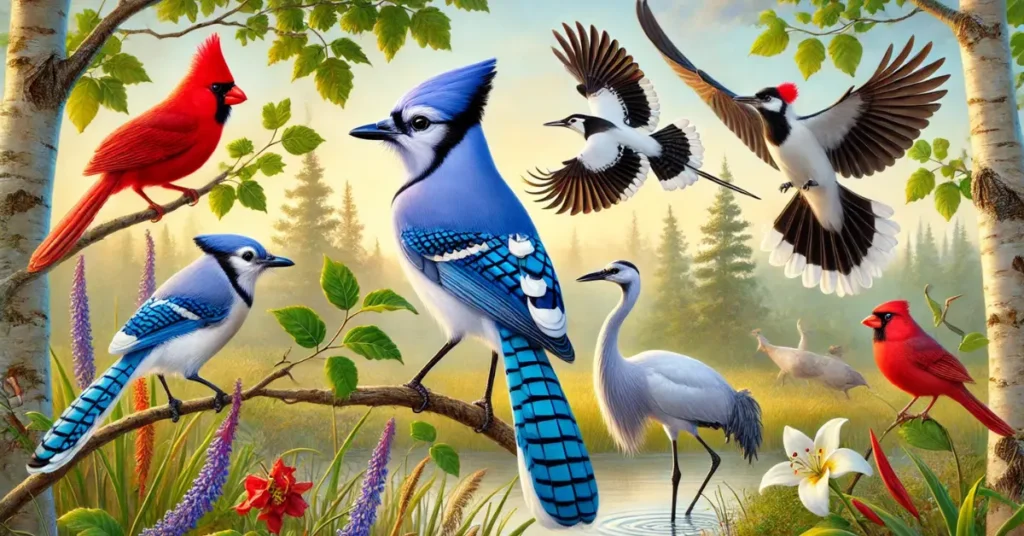Throughout history, various cultures have revered certain Birds as harbingers of good fortune, prosperity, and positive energy. These avian symbols often carry deep-rooted meanings, reflecting the values and beliefs of the societies that honor them. In this comprehensive exploration, we will delve into the top 5 birds that are widely considered to bring good luck, examining their cultural significance, symbolic meanings, and the reasons behind their esteemed statuses.
Table of Contents
Toggle5 Birds The Red Cardinal
The Red Cardinal, also known as the Northern Cardinal, is a vibrant songbird native to North America. Its striking crimson plumage and melodic songs have made it a beloved figure in various cultural narratives.
Cultural Significance:
In many Native American traditions, the Red Cardinal is seen as a messenger between the earthly realm and the spirit world. Spotting a cardinal is often interpreted as a sign that a departed loved one is nearby, offering guidance or reassurance. This belief underscores the bird’s association with vitality, warmth, and renewal.
Symbolic Meanings:
- Vitality and Energy: The cardinal’s bright red color symbolizes life force and energy, inspiring those who encounter it to embrace their inner strength and passion.
- Love and Devotion: Cardinals are monogamous birds, often seen in pairs, which has led to their association with enduring love and commitment.
- Hope and Renewal: Their year-round presence, even during harsh winters, serves as a reminder of resilience and the promise of new beginnings.
Attracting Red Cardinals:
To invite the presence of Red Cardinals into your surroundings, consider providing feeders stocked with their preferred seeds, such as sunflower or safflower seeds. Planting native shrubs and trees can also offer suitable nesting sites, encouraging these delightful birds to make a home in your area.
5 Birds The Blue Jay
The Blue Jay is a striking 5 birds known for its vibrant blue feathers and distinctive crest. Beyond its physical beauty, the Blue Jay holds a significant place in various cultural traditions.
Cultural Significance:
In Native American folklore, the Blue Jay is often seen as a symbol of clarity and vision. Its boldness and curiosity are admired traits, and encountering a Blue Jay is believed to be a sign that one is on the right path.
Symbolic Meanings:
- Communication: Blue Jays are known for their complex vocalizations, symbolizing the importance of effective communication and expression.
- Resourcefulness: Their adaptability in various environments reflects the value of resourcefulness and resilience.
- Loyalty: Blue Jays are monogamous and often mate for life, representing loyalty and fidelity.
Attracting Blue Jays:
To attract Blue Jays to your yard, offer peanuts, suet, and sunflower seeds. Providing a water source and planting oak trees, which produce acorns—a favorite food of Blue Jays—can also encourage their presence.
5 Birds The Magpie
The Magpie is a bird steeped in symbolism, with its black and white plumage and intelligent demeanor capturing human imagination across cultures.
Cultural Significance:
In East Asian cultures, particularly in China and Korea, the Magpie is considered a bearer of good news and a symbol of good fortune. Its appearance is often believed to herald the arrival of guests or the announcement of joyful events.
Symbolic Meanings:
- Joy and Happiness: The Magpie’s chattering calls are thought to bring joy and signify auspicious occasions.
- Prophecy: In some traditions, the number of Magpies seen together can be interpreted to predict future events, a concept popularized in the rhyme “One for sorrow, two for joy.”
- Transformation: The Magpie’s contrasting colors symbolize the balance of opposites and the transformative power of unity.
Attracting Magpies:
Magpies are attracted to open areas with scattered trees. Providing a variety of foods, including grains, fruits, and nuts, can entice them to visit. However, it’s essential to be mindful of local regulations and the ecological impact, as Magpies can sometimes be considered pests in certain regions.

5 Birds The Crane
Cranes are majestic birds celebrated for their grace and longevity. They hold a revered place in the mythologies and art of various cultures.
Cultural Significance:
In East Asian cultures, the Crane is a symbol of longevity, immortality, and fidelity. Japanese tradition holds that folding a thousand origami cranes grants the folder a wish, often associated with health and long life.
Symbolic Meanings:
- Longevity: Cranes are often depicted alongside symbols of longevity, such as pine trees and tortoises, reinforcing their association with a long life.
- Peace: Their calm demeanor and graceful movements make them emblems of peace and tranquility.
- Fidelity: Cranes are monogamous and mate for life, symbolizing unwavering commitment and faithfulness.
Attracting Cranes:
Attracting cranes to your environment can be challenging, as they prefer large wetlands and open fields. Conserving natural habitats and supporting wetland preservation efforts can contribute to the well-being of crane populations.
5 Birds The Hummingbird
The Hummingbird, with its iridescent feathers and rapid wing beats, is a marvel of the avian world. Its delicate beauty and energetic presence have inspired admiration and symbolism.
Cultural Significance:
In many cultures, the Hummingbird is seen as a messenger of joy and a symbol of resilience. Its ability to hover and move swiftly in any direction is often associated with adaptability and lightness of being.
Symbolic Meanings:
- Joy and Beauty: The Hummingbird’s vibrant appearance and swift movements symbolize happiness and appreciation for life’s small moments.
- Endurance and Strength: Despite its small size, the Hummingbird exhibits remarkable stamina, embodying resilience and perseverance.
- Love and Attraction: Many cultures associate Hummingbirds with love and attraction due to their dazzling appearance and energetic nature.
Attracting Hummingbirds:
To attract Hummingbirds, plant nectar-rich flowers such as honeysuckle, salvia, and bee balm. Providing sugar-water feeders can also help sustain them, especially during migration periods.
Conclusion
5 Birds have long been symbols of fortune, wisdom, and hope in human culture. Whether it’s the Red Cardinal’s message of renewal, the Blue Jay’s encouragement of communication, the Magpie’s joyful announcements, the Crane’s promise of longevity, or the Hummingbird’s inspiration of joy, these birds remind us of nature’s ability to bring positivity into our lives. By understanding their meanings and attracting them into our surroundings, we can embrace their energy and invite good luck into our lives.
FAQs
Which bird is considered the luckiest in most cultures?
The Crane is often regarded as one of the luckiest birds due to its association with longevity, wisdom, and prosperity, especially in East Asian cultures.
Do these 5 birds bring actual luck, or is it just symbolism?
While there is no scientific proof that birds bring luck, their symbolism can inspire positive thinking and mindfulness, which can lead to good fortune in one’s life.
How can I attract more lucky 5 birds to my backyard?
Providing food sources, clean water, and safe nesting areas can encourage birds like Cardinals, Blue Jays, and Hummingbirds to visit your yard.
Are there any birds considered unlucky?
Some cultures view birds like the Crow or Owl as omens of misfortune, but interpretations vary widely depending on the region and belief system.
Can keeping these 5 birds as pets bring luck?
It is generally best to admire these 5 birds in the wild rather than keep them as pets, as they thrive in their natural habitats.










